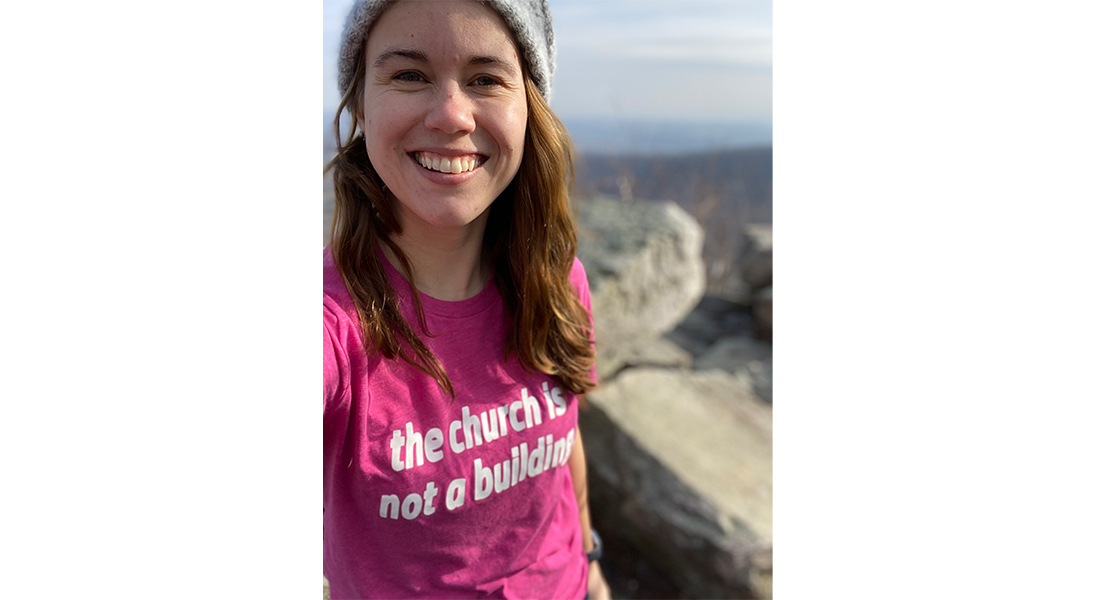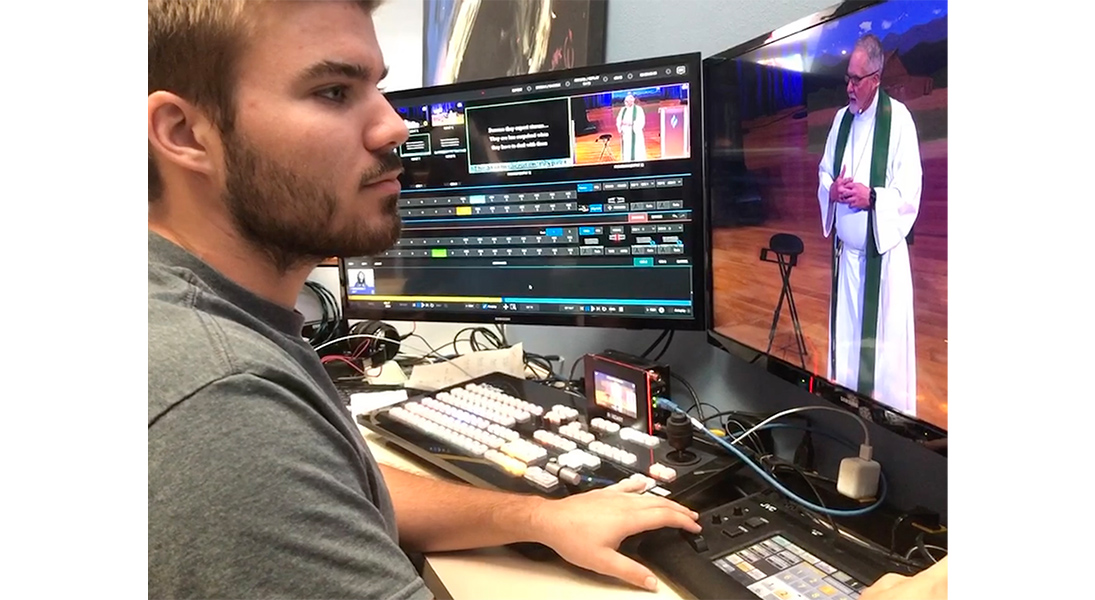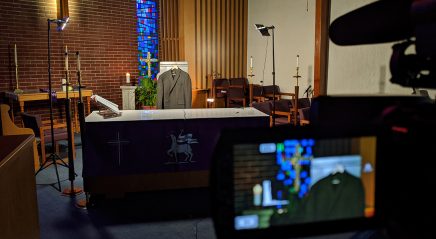Bounce around the internet for a while and you’ll catch wind of how virtual reality experiences, such as those sought in the metaverse, are supposed to change the world—and soon.
Pre-COVID-19, these conversations might not have meant much to congregations. But since the outbreak of the pandemic, which forced nearly all congregations to close their doors at some point and made “going digital” one of the only ways to connect with congregants, conversations about the digital future have taken on new meaning for the church.
“Every church dealt with this and has its own story regarding what decisions they came to [during the pandemic],” said Craig Mueller, a pastor of Holy Trinity Lutheran Church in Chicago. “Nearly every church is continuing some kind of worship presence online, even if they weren’t doing it before, so it really is a whole new world.”
Today, some churches are expressing further interest in that “whole new world” in the context of the metaverse, a 3D virtual world accessed when a person straps on a virtual reality headset. The technology gives them the sensation of “stepping” inside a virtual community—which could easily be a church, some spiritual leaders have said.
And though some congregations are sprinting toward the latest in digital church, most remain comfortably in hybrid mode: offering both in-person and online opportunities to gather. Some are slowly moving back into pre-COVID ways of existing almost exclusively in-person.
Is there a right or wrong way for churches to assemble in a post-pandemic future?
Is there a right or wrong way for churches to assemble in a post-pandemic future?
“The pandemic just exploded our sense of what church is, what being connected to people is, what community looks like,” said Deanna Thompson, director of the Lutheran Center for Faith, Values, and Community at St. Olaf College, Northfield, Minn. “There’s not a one-size-fits-all [solution].”
In his book Any Body There?: Worship and Being Human in a Digital Age (Wipf & Stock, 2017), Mueller argues that in-person, embodied, sacramental worship is an antidote to our fast-paced, distracted digital lives.
Today he still believes that. But he also concedes that online components of the church are necessary.
“I feel most comfortable thinking that it always needs to be parallel, that there always needs to be encouragement for in-person participation—if health and distance allow it—for experiencing bodily not only the sacraments but the engagement of our senses,” he said. “But with health and distance [as part of the equation], we do need to provide digital options for people.”
Thompson said churches need to have thoughtful conversations with their community and ask the questions that will lead them to serve their congregation best.
“What did we learn about what it means to be church during the pandemic? How did these tools help us, how did they make things harder, how do we want to be with people moving forward?” she asked.
“I think there’s room for, hopefully, experimentation.”
Deep questions
Determining participation in digital worship isn’t simply a question of whether a church has the resources, both monetary and bodily, to provide such opportunities.
“We’re in an interesting position right now because there are still some deep theological questions that parallel the technological ones,” said John Weit, a deacon and the ELCA executive for worship. “And we’re taking our time to not rush to answers. So it would be difficult to give concrete answers to [these] questions, but more to note that the questions will continue to be in front of us for some time as we navigate these waters as church and world.”
Part of the sensitivity of parsing those big questions is that Lutherans are centered in word and sacrament, Mueller said. “Our liturgy is meant to not only be multisensory and embodied, but participatory,” he said.
Mueller believes congregations need to make sure they’re asking questions and talking through the answers rather than thinking there are absolute paths forward right now.
“[During] the pandemic, my experience showed that people can experience community online and they also can experience divine presence, which, in some ways, is surprising to people,” he said. “What I learned through my experience and now through other people who watch primarily online [is that] they are experiencing grace and the gospel … while being online.
“We all are needing to take this into account and are in some ways having to think theologically about it in retrospect. People now worship online and there is no going back.”
Reaching those who need community most
Unlike most congregations, Faith Lutheran in Flower Mound, Texas, got on the digital bandwagon early.
When Rusty Sullivan began his call as a pastor of Faith in 2010, the congregation didn’t have any digital ministry; there weren’t even projector screens in the church, he said.
“That was fine, but we went to work pretty early on to say, listen, if we’re going to be a place for all people—and all means all—[if] we want to be able to connect with people of different backgrounds and interests and passions, then we’re going to need to diversify the ways in which we’re going to share the gospel,” he said.
Faith created an in-house digital ministry, and the congregation’s first online broadcast took place in 2017.
The church had been online for only a few months when the lone staff member who ran the streaming system was hospitalized on a Saturday night. Faith couldn’t broadcast its service the next day.
That Monday, Sullivan received a call from someone in rural Wyoming questioning why the Sunday service hadn’t been broadcast. The man explained he had been gathering with about 20 other people each week for nearly two months to watch Faith’s services online and then have lunch and discuss the sermon.
“They didn’t have a church close by they were connected with,” Sullivan recalled. “After I apologized profusely to him, I said to him, ‘I tell you what, you hang in there with us, and I promise … our failure to adequately plan will not happen again.’
“We’ve never missed a broadcast since.”
Sullivan said communicating the importance of digital media was difficult at that time because from 2017 to 2019 only about a dozen of the ELCA’s 125 largest congregations were doing any meaningful work online. Online worship was often criticized by others in ministry, he said, adding, “That wasn’t authentic church to them.”
“Now’s a great time to be saying, as a church, ‘How can we use these tools strategically?’”
Beginning in March 2020, Sullivan started fielding around 15 calls a day from those same colleagues, and many others, asking how to build an online presence.
“As game-changing as the printing press was to the Reformation … so, too, is digital technology for our 21st-century ministry mission,” he said. “That was the truth prior to the pandemic, which is why we were already heavily invested years before it happened. But now the world has experienced church in a new way. … It’s a mistake to think we can, or should, put the genie back in the bottle.”
Thompson, once a digital skeptic, agreed.
In her book The Virtual Body of Christ in a Suffering World (Abingdon Press, 2016), Thompson chronicles her life after being diagnosed with Stage 4 cancer and shares how digital tools helped her heal.
“To my shock, digital spaces were spaces where I could feel most myself when I was really sick, because in-person communication was really, really painful. People would look at my body, [which] looked like I was dying, and that determined the conversation,” she said.
Thompson noted Paul’s admonition in 1 Corinthians 12 that the members of the body who seem weakest are the least dispensable. Those are the people on whom the church should be focused most fully, she said.
“Some people are not coming back to church because they like being in their PJs on a Sunday morning,” she acknowledged. “But a lot of people are [immunocompromised]. Some, when COVID started, were 87. Now they’re 90. Many will not come back. [For] people with children with significant sensory issues, worshiping in-home is a better experience for their family. Many of our churches are not ADA-accessible … there’s a lot of barriers to in-person worship.
“We can be so much more discerning now than we could have been back before the pandemic,” she continued. “There are ways that [digital worship] is inferior to in-person … but now’s a great time to be saying, as a church, ‘How can we use these tools strategically?’”
Pairing online and in-person ministry
Daniel Kirschbaum, ELCA director for Young Adult Ministry, said one question he heard asked most often during COVID was, “Is a real community something we could accomplish in a digital world?”
After helping launch Abide, an online small-group ministry for young adults, in 2020, Kirschbaum had an answer.
“Yes—100%, yes,” he said. “Community and connection happened in a digital space because we were still able to create new relationships. They had, if anything, more [connection] to one another.”
So how will those connections change and develop in a post-COVID world?
Something Sullivan has emphasized time and again with his own digital skeptics is that Faith—and other similar congregations—are interested in digital worship not as a way of putting on a show but as a means of increasing connection.
“We don’t want an audience, we want a church,” he said. “That’s also why we’re always trying to encourage them to connect where they are. ‘Building relationships that matter’ is our [congregation’s] tagline. You cannot love from afar. … You can connect in terms of transferring information and concerns, but you’ve got to love up close and personal. And we’re called to love God and love people. That has to translate into some real and tangible ways.”
“It’s about, why do you go to church, anyway?”
Faith encourages online followers to join a small group or to find other ways to connect to people in their area, Sullivan said. After the congregation recently worked on a build with Habitat for Humanity, he mentioned it during a service. Subsequently, many of Faith’s small groups around the country also volunteered locally with the organization.
Pre-COVID, Sammy Kelly and Michele Barra met while both serving at New Life Evangelical Lutheran Church in New Tripoli, Pa. They bonded over recognizing that digital media was a ministry, and that many congregations needed help navigating that ministry.
In 2019 they co-founded Digivangelism to help spiritual communities reach people online. The company provides digital ministry guides, courses and reviews to help leaders “be church online.”
Digivangelism exists to aid groups in building their digital media presence, yet Barra believes online resources should also support in-person endeavors.
“Churches who are going to thrive after this are going to be the ones who have both options open, who maintain a digital presence to give opportunities to those who geographically aren’t close to them, who don’t want to come anymore, or younger folks who it’s not a timely convenience for,” she said.
“[But] you can’t work at a food bank digitally. You can’t have a school backpack fundraiser digitally. It’s not just about you, it’s about, why do you go to church, anyway? To follow Jesus, to do what he says to do: feed the hungry, clothe the sick. And we do those things in relational, in-person ways.”
The metaverse and beyond
Some ELCA congregations are already discussing what many see as part of the future of digital worship: expanding into the metaverse.
“I just got my first Oculus six to eight months ago,” said Sullivan, referring to the virtual-reality headset. “As soon as I put my Oculus on, I thought, ‘This is awesome. If it’s awesome for me to play a game, then why wouldn’t it be awesome for me to share the gospel?’ I don’t know yet how we’re going to do that, but certainly I think that’s going to be a next step for us.”
Hope Palm Desert, an ELCA congregation in Palm Desert, Calif., sees the metaverse as the natural next step in expanding its online presence. Rick Bailard, online leader of Hope Palm Desert, noted that churches utilizing the metaverse aren’t novel—Life.Church has existed solely in the metaverse since 2016.
“It’s just a new world now,” he said. “You’re just not going to be able to do church as your grandparents did church 10, 15 years down the road. No one in their 30s or younger are going to go to a church in which the technology is so far behind.”
Phil LaDeur, ELCA program manager for innovation and ideas, said his work is focused on how people outside the ELCA are finding meaning and belonging.
“The metaverse is one of those places where that’s happening,” he said. “Our team has spent time in the metaverse and are discovering some of the unique ways people are using that space to create community. For example, the deaf and hard of hearing community has a large presence in social [virtual reality] worlds. [Not only] can they educate people about [their] community, they create their own hangout space and sign in real time with other users.”
Similarly, LaDeur said, neurodivergent users have entered the metaverse to create their own immersive worlds that convey their experience of the physical world to their friends and family.
The goal of utilizing any digital media, even the metaverse, isn’t to use technology for technology’s sake, Bailard said.
“If you’re in [a] rural area where your people are still coming to church with [a] horse and buggy and that works for you, then do it,” he said. “We’re not saying there is one method, all online, you have to use it. We’re just saying there’s a big world out there, and if we can use technology to reach people we can’t even see right now … why would you want us not to do that?”











